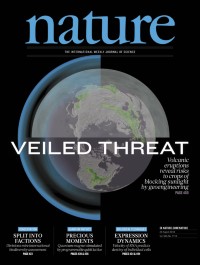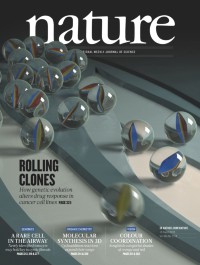Volume 560
-
No. 7720 30 August 2018
Lean and greenThe green revolution of the 1960s helped to boost agriculture through the creation of high-yield cereal crops. But these elite crops, known as green revolution varieties (GRVs), have a problem: they are poor at using nitrogen and so require high amounts of environmentally damaging fertilizer to reach their full potential. In this week’s issue, Xiangdong Fu and his colleagues reveal that boosting the activity of the protein GRF4 improves the plants’ nitrogen usage while maintaining their high yield. They suggest that applying this result in breeding strategies for GRVs could contribute to the drive for sustainable agriculture.
-
No. 7719 23 August 2018
Veiled threatThe cover illustrates how the dust veil generated by the 1991 eruption of Mount Pinatubo in the Philippines shaded and cooled Earth. This, in part, inspired geoengineering proposals to mitigate the effects of a warming climate by injecting precursors to sulfate aerosols into the stratosphere. In this week’s issue, Jonathan Proctor and his colleagues use the eruptions of Mount Pinatubo and of El Chichón in Mexico (1982) as natural experiments to study the effects of such aerosol veils on global crop yields. They find that the changes in sunlight induced by the stratospheric aerosols had a negative effect on the yields of maize, soy, rice and wheat. The researchers then model a geoengineering scenario and find that the technology’s benefits to crop production from cooling are washed out by its damages from shading. These results suggest that solar geoengineering using sulfate aerosols would fail to mitigate the danger that climate change poses to global agricultural production and food security.
-
No. 7718 16 August 2018
Rolling clonesThe cover image shows a number of marbles rolling down a slope. Much like the cell lines they represent, these marbles all look superficially similar, but on closer examination those farther down the slope are showing changes in their internal patterning, which reflect the results found in this week’s issue by Todd Golub and his colleagues. Looking at cancer cell lines, the researchers show that far from being clonal, the cell line ‘strains’ display differences in genomic alterations, gene-expression profiles, proliferation rates and drug response, all of which arise as a result of genetic and transcriptional evolution. Their findings have implications for cancer research using such cell lines and the team has created a publicly available online tool called Cell STRAINER to help assess cell-line divergence.
-
No. 7717 9 August 2018
Brain drainThe task of removing waste products such as cellular debris and toxic molecules from the body’s tissues is performed by lymphatic vessels. In this week’s issue, Jonathan Kipnis and his colleagues reveal that the brain also makes use of this system, by moving macromolecular waste in cerebral fluids to be drained through lymphatic vessels located within the meninges — the membranes that cover the brain. They find that, in normal mice, cognitive function is reduced if the meningeal lymphatics become impaired. The researchers also show that ageing damages the lymphatics and that restoring their function is associated with recovered ‘brain cleansing’ and improved memory. Working with a mouse model for Alzheimer’s disease, the team reveals that if the meningeal lymphatic vessels are disrupted, clearance of the protein amyloid-β is impaired leading to accumulation in the brain, which worsens the amyloid pathology. The team suggests that targeting decline in the meningeal lymphatic system could be a useful therapeutic route to help combat age-related cognitive dysfunction.
-
No. 7716 2 August 2018
Deep blueThe extent to which Earth’s surface materials are recycled into the deep mantle is difficult to evaluate. In this week’s issue, Evan Smith and his colleagues shed light on the matter through an examination of blue (type IIb) diamonds. These rare gems get their colour from boron, an element predominantly found in the crust, which suggests boron somehow made its way to the high-pressure environment below the surface where diamonds form. The team’s analysis of mineral inclusions trapped inside boron-bearing diamonds reveals that they crystallized in oceanic lithosphere (oceanic tectonic plates) that had been subducted down to the lower mantle (at least 660 km below Earth’s surface, much deeper than the 200 km limit typical for most diamonds), meaning blue diamonds are among the most deeply sourced diamonds known. The researchers propose that boron was carried down in seawater-altered oceanic lithosphere, illustrating a viable pathway for the deep-mantle recycling of crustal elements.





